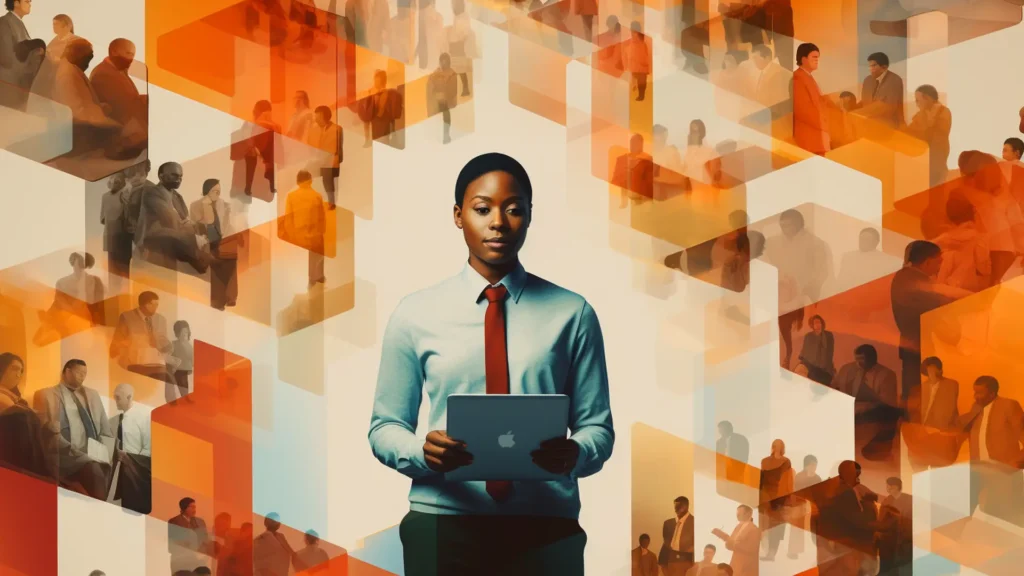Key Takeaways
- ERGs create a platform for employees with shared characteristics or experiences to come together, connect, and advocate for positive change.
- Implementing ERGs in the workplace leads to a range of benefits, such as enhanced employee morale, improved diversity and inclusivity, higher productivity levels, better employee retention rates, and a strengthened employer brand.
- To start an ERG, companies should assess management support, find an executive sponsor for the program, and gauge interest from employees by sending out surveys.
- ERGs foster an employee's strong bond and loyalty to a company while providing camaraderie, which staves off employee dissatisfaction and turnover.
Listen: How to foster belonging with employee resource groups.
Before I attended my first Employee Resource Group (ERG) meeting for Celebrate Neurodiversity, I spent my professional career suppressing what goes on in my head and much of my personality. I had considered disclosing to an employer that I have major depressive disorder and ADHD, among other things, but always assumed doing so was a job-ending liability. The mental and emotional toll of two decades of masking, compensating, and apologizing from 9 to 5 was all part of working and earning a paycheck. I figured everyone used a diluted version of themselves—their work brain—and “getting the job done” was good enough.
I had no idea what I was missing out on until I joined Aquent's neurodiversity ERG. The genuine sense of belonging, acceptance, and shared experience that I felt was immediate and stunning. That this sense came from coworkers was even more amazing. For so long, I had resigned myself to hiding who I was at work and, consequently, not making deep connections with the people I worked with.
The many benefits of ERGs

At their core, ERGs are employee-driven programs that celebrate diversity and foster inclusion in the workplace. They do this by providing platforms for employees with shared identities or experiences to come together, connect, and advocate for positive change.
And it’s not only individual employees who benefit. Companies that support ERGs can reap a multitude of benefits that extend to the entire organization.
Firstly, ERGs uplift employee morale by creating a sense of belonging and community within the workplace. This leads to increased job satisfaction, higher engagement levels, and ultimately, improved productivity. For example, a study conducted by Deloitte found that organizations with ERGs experienced 18% higher employee productivity compared to those without.
ERGs have also proven to be effective in improving diversity and inclusivity in the workplace. By providing a support system and resources for underrepresented groups, ERGs help break down barriers, promote equal opportunities, and encourage diverse talent to thrive. A case in point is the ERG for women in technology at Microsoft, which resulted in a 40% increase in female representation in technical roles over a five-year period.
Additionally, ERGs contribute to better employee retention rates by fostering a sense of loyalty and commitment among employees. Research by Catalyst has shown that ERGs significantly reduce turnover rates, saving companies valuable time and resources associated with recruitment and onboarding.
Moreover, ERGs strengthen an employer's brand and reputation, making them more attractive to potential employees and customers alike. Companies that prioritize ERGs are often seen as progressive and inclusive, which can positively impact recruitment efforts and customer loyalty. In fact, a survey conducted by Glassdoor revealed that 67% of job seekers consider a company's diversity and inclusion practices when making career decisions.
At many companies, ERGs thrive with little or no budget and ask nothing from the C-suite other than their approval of the groups’ existence. In fact, some could argue that ERGs are better without any participation from upper management whatsoever.
What's involved: example ERG meeting structure and guidelines
Currently, Aquent has eight ERGs that meet regularly: BIPOC (Black, Indigenous, and People of Color), Celebrate Neurodiversity!, Dealing with Grief, Latin-ish @ Aquent, LGBTQIA+ and Allies, Sustainability / Environment Club, The Women's Group, and Working Parents.
All meet at least once a month for an hour, with a suggested topic to encourage conversation. Groups may also have open-ended 30-minute “break room” meetings with varying frequencies—most meet bi-monthly.
Each group has two to three co-chairs who come up with the topics. In the neurodiversity ERG, we’ve found that three co-chairs is a magic number, making it easier to accommodate varying work calendars so that at least one co-chair can formally or informally lead the monthly meetings and be in attendance for each short, open-ended meeting.
Groups are encouraged to develop guidelines that create an environment in which people are comfortable sharing. At the beginning of each neurodiversity monthly meeting, for example, we read the following:
- This is a SAFE SPACE where we are all equal regardless of our Aquent job position, seniority, etc.
- Everything said in this space is confidential unless explicit permission is given to share elsewhere.
- No one should feel at all pressured to divulge any specific medical information / diagnosis, and any such disclosure by a group member should be assumed confidential.
- Be respectful to others and give everyone a chance to be heard.
- Practice “Ouch and Oops”—Ouch! is when you hear something you find hurtful, offensive, etc.; Oops! is when you unintentionally communicate in a way that is hurtful, offensive, etc. to someone else. These are opportunities for all of us to learn and grow.
- We welcome the use of the “Raise Hand” feature in Google Meet.
- Our guidelines are curated as a group and can be expanded and amended—see something missing? Let's talk about it!
Recommendations for starting an ERG
Depending on the size and structure of your company, there may be some challenges in establishing a new ERG. Here are our learnings from starting new ERGs at Aquent.
First, assess if there is management support for an ERG and, ideally, find an executive sponsor for the program. At Aquent, we formalized support and took it a step further by establishing an ERG Facilitators Peer Group to provide support and guidance for the ERG leaders, and a DEI Council. The DEI Council oversees the peer group, the ERGs, and serves as a resource for the group leaders.
Gauge interest from employees by sending out a survey. When we first started our ERGs, we wanted employees to feel included. We launched during the height of the pandemic, so one of the first groups was a Working Parents group because they were feeling the brunt of trying to balance work and school-age children at home. From there, we expanded into other groups.
We typically have the groups begin as a club to assess if there is sustained interest from the employees in continuing to meet on a regular basis. After several months, the club can become an ERG. We allow employees to suggest new groups and most recently started a women's group as well as one focused on the environment.
Each group can survey its members to determine the best time to meet, and we encourage the co-leaders to share the topics in advance so that the members can self-select whether or not they attend due to the topic.
A few warnings. With any meeting invite involving more than two people's calendars, there is no such thing as a good time for every meeting. Depending on the interests, hierarchical structure, and culture of your company, employees may be apprehensive about speaking in an ERG meeting if upper management is present. If an employee in upper management attends, it should be clear that they are attending as a member of the group and not as an executive.
Don't wait to start your ERG

The positive impacts and feelings of camaraderie an ERG can give employees provide incalculable benefits for employers as well. People often say they stay at a company for their manager (or worry about leaving them). ERGs can similarly foster an employee’s strong bond and loyalty to a company while staving off employee dissatisfaction and turnover.
After exploring the benefits of ERGs, I am confident that they can truly enhance any workplace. Participation in Celebrate Neurodiversity! has positively impacted my life in both mundane and profound ways; the support and sense of community I’ve found within this group have empowered me personally and professionally. It has granted me the confidence to step out of my comfort zone and write this article, something that two years ago, I would have never done, and thought would only make me susceptible to ridicule. By fostering inclusivity and providing a platform for diverse voices to be heard, ERGs contribute to a more vibrant and welcoming environment for any employee.
Latest.

The best marketing automation tools for 2026.
Engineering & Technology, Innovation & Emerging Tech, Marketing & Analytics

Reimagining org design in the fast-paced new world of AI.
Insights from InsideOut, Leadership & Management, Content & Creative

Meet the new emerging role: AI Trainer
Career Advice, Leadership & Management, Engineering & Technology, Innovation & Emerging Tech, Talent Acquisition & Recruitment



